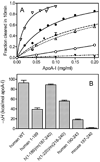Interaction between the N- and C-terminal domains modulates the stability and lipid binding of apolipoprotein A-I
- PMID: 19239199
- PMCID: PMC2936823
- DOI: 10.1021/bi802317v
Interaction between the N- and C-terminal domains modulates the stability and lipid binding of apolipoprotein A-I
Abstract
The tertiary structures of human and mouse apolipoprotein A-I (apoA-I) are comprised of an N-terminal helix bundle and a separate C-terminal domain. To define the possible intramolecular interaction between the N- and the C-terminal domains, we examined the effects on protein stability and lipid-binding properties of exchanging either the C-terminal domain or helix between human and mouse apoA-I. Chemical denaturation experiments demonstrated that replacement of the C-terminal domain or helical segment in human apoA-I with the mouse counterparts largely destabilizes the N-terminal helix bundle. Removal of the C-terminal domain or alpha-helix in human apoA-I had a similar effect on the destabilization of the helix bundle against urea denaturation, indicating that the C-terminal helical segment mainly contributes to stabilizing the N-terminal helix bundle structure in the apoA-I molecule. Consistent with this, KI quenching experiments indicated that removal or replacement of the C-terminal domain or helix in human apoA-I causes Trp residues in the N-terminal domain to become exposed to solvent. Measurements of the heats of binding to egg phosphatidylcholine (PC) vesicles and the kinetics of solubilization of dimyristoyl PC vesicles demonstrated that the destabilized human N-terminal helix bundle can strongly interact with lipids without the hydrophobic C-terminal helix. In addition, site-specific labeling of the N- and C-terminal helices by acrylodan to probe the conformational stability and the spatial proximity of the two domains indicated that the C-terminal helix is located near the N-terminal helix bundle, leading to a relatively less solvent-exposed, more organized conformation of the C-terminal domain. Taken together, these results suggest that interaction between the N- and C-terminal tertiary structure domains in apoA-I modulates the stability and lipid-binding properties of the N-terminal helix bundle.
Figures





Similar articles
-
Influence of tertiary structure domain properties on the functionality of apolipoprotein A-I.Biochemistry. 2008 Feb 19;47(7):2172-80. doi: 10.1021/bi702332b. Epub 2008 Jan 19. Biochemistry. 2008. PMID: 18205410
-
Influence of N-terminal helix bundle stability on the lipid-binding properties of human apolipoprotein A-I.Biochim Biophys Acta. 2011 Jan;1811(1):25-30. doi: 10.1016/j.bbalip.2010.10.003. Epub 2010 Oct 30. Biochim Biophys Acta. 2011. PMID: 21040803 Free PMC article.
-
Contributions of the N- and C-terminal helical segments to the lipid-free structure and lipid interaction of apolipoprotein A-I.Biochemistry. 2006 Aug 29;45(34):10351-8. doi: 10.1021/bi060726t. Biochemistry. 2006. PMID: 16922511
-
Apolipoprotein A-I: structure-function relationships.J Lipid Res. 2000 Jun;41(6):853-72. J Lipid Res. 2000. PMID: 10828078 Review.
-
Lipid-free Apolipoprotein A-I Structure: Insights into HDL Formation and Atherosclerosis Development.Arch Med Res. 2015 Jul;46(5):351-60. doi: 10.1016/j.arcmed.2015.05.012. Epub 2015 Jun 3. Arch Med Res. 2015. PMID: 26048453 Free PMC article. Review.
Cited by
-
Disruption of the C-terminal helix by single amino acid deletion is directly responsible for impaired cholesterol efflux ability of apolipoprotein A-I Nichinan.J Lipid Res. 2010 Apr;51(4):809-18. doi: 10.1194/jlr.M002113. Epub 2009 Oct 5. J Lipid Res. 2010. PMID: 19805625 Free PMC article.
-
Enhanced binding of apolipoprotein A-I variants associated with hypertriglyceridemia to triglyceride-rich particles.Biochemistry. 2011 Mar 29;50(12):2040-7. doi: 10.1021/bi200158b. Epub 2011 Feb 20. Biochemistry. 2011. PMID: 21288012 Free PMC article.
-
Structure of apolipoprotein A-I N terminus on nascent high density lipoproteins.J Biol Chem. 2011 Jan 28;286(4):2966-75. doi: 10.1074/jbc.M110.163097. Epub 2010 Nov 3. J Biol Chem. 2011. PMID: 21047795 Free PMC article.
-
Characterization of type IV antifreeze gene in Nile tilapia (Oreochromis niloticus) and influence of cold and hot weather on its expression and some immune-related genes.Fish Physiol Biochem. 2018 Apr;44(2):515-525. doi: 10.1007/s10695-017-0450-4. Epub 2017 Dec 12. Fish Physiol Biochem. 2018. PMID: 29234908
-
The helix bundle: a reversible lipid binding motif.Comp Biochem Physiol A Mol Integr Physiol. 2010 Feb;155(2):123-33. doi: 10.1016/j.cbpa.2009.09.009. Epub 2009 Sep 19. Comp Biochem Physiol A Mol Integr Physiol. 2010. PMID: 19770066 Free PMC article. Review.
References
-
- Curtiss LK, Valenta DT, Hime NJ, Rye KA. What is so special about apolipoprotein AI in reverse cholesterol transport? Arterioscler Thromb Vasc Biol. 2006;26:12–19. - PubMed
-
- Tall AR, Yvan-Charvet L, Terasaka N, Pagler T, Wang N. HDL, ABC transporters, and cholesterol efflux: implications for the treatment of atherosclerosis. Cell Metab. 2008;7:365–375. - PubMed
-
- Krimbou L, Marcil M, Genest J. New insights into the biogenesis of human high-density lipoproteins. Curr Opin Lipidol. 2006;17:258–267. - PubMed
-
- Oram JF, Vaughan AM. ATP-Binding cassette cholesterol transporters and cardiovascular disease. Circ Res. 2006;99:1031–1043. - PubMed
Publication types
MeSH terms
Substances
Grants and funding
LinkOut - more resources
Full Text Sources
Other Literature Sources
Molecular Biology Databases
Miscellaneous

